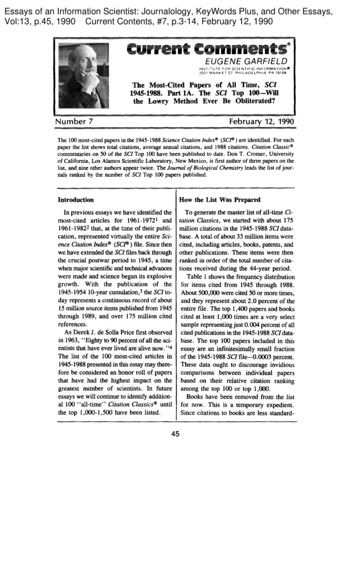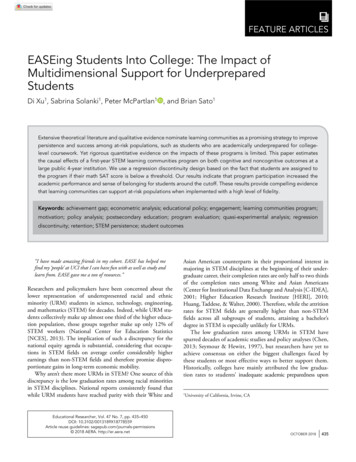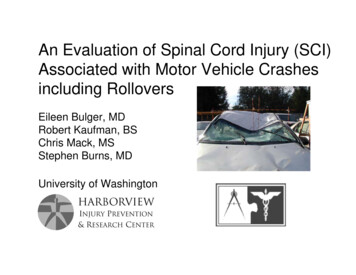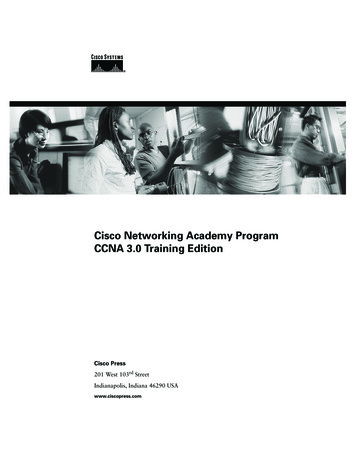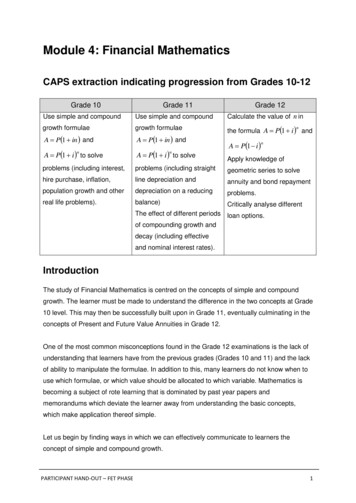
Transcription
Module 4: Financial MathematicsCAPS extraction indicating progression from Grades 10-12Grade 10Grade 11Grade 12Use simple and compoundUse simple and compoundCalculate the value of n ingrowth formulaegrowth formulaeA P 1 in andA P 1 in andthe formula A P 1 i andA P 1 i to solveA P 1 i to solveApply knowledge ofproblems (including interest,problems (including straightgeometric series to solvehire purchase, inflation,line depreciation andannuity and bond repaymentpopulation growth and otherdepreciation on a reducingproblems.real life problems).balance)Critically analyse differentnnA P 1 i nnThe effect of different periods loan options.of compounding growth anddecay (including effectiveand nominal interest rates).IntroductionThe study of Financial Mathematics is centred on the concepts of simple and compoundgrowth. The learner must be made to understand the difference in the two concepts at Grade10 level. This may then be successfully built upon in Grade 11, eventually culminating in theconcepts of Present and Future Value Annuities in Grade 12.One of the most common misconceptions found in the Grade 12 examinations is the lack ofunderstanding that learners have from the previous grades (Grades 10 and 11) and the lackof ability to manipulate the formulae. In addition to this, many learners do not know when touse which formulae, or which value should be allocated to which variable. Mathematics isbecoming a subject of rote learning that is dominated by past year papers andmemorandums which deviate the learner away from understanding the basic concepts,which make application thereof simple.Let us begin by finding ways in which we can effectively communicate to learners theconcept of simple and compound growth.PARTICIPANT HAND-OUT – FET PHASE1
Simple and Compound Growth What is our understanding of simple and compound growth? How do we, as educators, effectively transfer our understanding of these concepts to ourlearners? What do the learners need to know before we can begin to explain the difference insimple and compound growth?A star educator always takesinto account the dynamicsof his/her classroomThe first aspect that learners need is to understand the terminology that is going to be used.Activity 1: Terminology for Financial MathsGroup organisation: Time:Resources:Appendix:Groups of 6 FlipchartNone Permanent markers30 minIn your groups you will:1.Select a scribe and a spokesperson for this activity only – should rotate from activityto activity.2.Use the flipchart and permanent markers to write down definitions/explanations thatyou will use in your classroom to explain to your learners the meaning of thefollowing terms: Interest Principal amount Accrued amount Interest rate Term of investment Per annum3.Every group will have an opportunity to provide feedback.PARTICIPANT HANDOUT – FET PHASE2
Notes:Now that we have a clear understanding of the terms that we are going to use, let us try andunderstand the difference between Simple and Compound growth.We will make use of an example to illustrate the difference between these two concepts.Worked Example 1: Simple and Compound Growth(20 min)The facilitator will now provide you with a suitable example to help illustrate the differencebetween simple and compound growth.Example 1:Cindy wants to invest R500 in a savings plan for four years. She will receive 10% interestper annum on her savings. Should Cindy invest her money in a simple or compound growthplan?Solution:Simple growth plan:Interest is calculated at the start of the investment based on the money she is investing andWILL REMAIN THE SAME every year of her investment. 10 Interest 500 100 R50This implies that every year, R50 will be added to her investment.Year 1Year 2Year 3Year 4: R500 R50 R550: R550 R50 R600: R600 R50 R650: R650 R50 R700PARTICIPANT HAND-OUT – FET PHASEN Notice that theinterest remainsthe same everyyear.3
Cindy will have an ACCRUED AMOUNT of R700. Her PRINCIPAL AMOUNT was R500.Compound Growth Plan:The compound growth plan has interest that is recalculated every year based on the moneythat is in the account. The interest WILL CHANGE every year of her investment.Year 1: 10 Interest 500 100 R50Therefore, at the end of the 1st year Cindy will have R500 R50 R550Year 2: 10 Interest 550 100 R55NNotice that the interest isrecalculated based on theamount present in theaccount.Therefore, at the end of the 2nd year Cindy will have R550 R55 R605Year 3: 10 Interest 605 100 R60.50NNotice that the interest isrecalculated based on theamount present in theaccount.Therefore, at the end of the 3rd year Cindy will have R605 R60.50 R665.50Year 4: 10 Interest 665.50 100 R66.55NNotice that the interest isrecalculated based on theamount present in theaccount.Therefore, at the end of the 4th year Cindy will have R665.50 R66.55 R732.05Cindy will have an ACCRUED AMOUNT of R732.05. Her PRINCIPAL AMOUNT was R500.PARTICIPANT HANDOUT – FET PHASE4
Now that we understand the difference between simple and compound growth it is evidentthat if we are required to perform a simple or compound growth calculation, it would betiresome to conduct that calculation in the above manner. We will use the following formulaeto help us simplify our calculations.SIMPLE GROWTH:A P 1 in COMPOUND GROWTH:A P 1 i nIn both formulae:A Accrued amountP Principal amounti Interest raten Number of times interest is calculatedCommon Errors:In applying these formulae, some of the most common errors found are as follows:1. The accrued amount is the amount that will be received at the end of the investmentperiod. This is NOT the same as the interest earned. Many times a question will askwhat was the interest earned and the learner will provide the accrued amount as theanswer. The accrued amount is actually the principal amount plus the interest:( A P I ).2. The interest rate is always divided by 100 in all calculations, since it is given as a i n and 100 percentage. We should perhaps modify the equation to be A P 1 ni A P 1 respectively so that the learners do not forget to divide the interest 100 rate.3. Learners need to understand that interest can work for and against an individual. Itworks to an individual’s benefit when they invest a sum of money and works againstthem when they borrow a sum of money. Ensure that the learner understands thatwhen money is borrowed the ACCRUED AMOUNT is the amount that has to be paidback and the PRINCIPAL AMOUNT is the initial amount that was borrowed.PARTICIPANT HAND-OUT – FET PHASE5
4. The variable n is often mistaken for the period of the investment. This is, however,very misleading. For example, if a person invests money for two years where it iscompounded monthly, the value of n 24 instead of 2. Therefore, a more correctdefinition for n should be the number of times interest is calculated.5. Interest may be compounded:Bi-annually (twice a year)Semi-annually (twice a year)Quarterly (four times a year)Monthly (12 times a year)Daily (365 times a year)These terms will all affect the value of n .Worked Example 2: Simple and Compound Growth(20 min)The facilitator will now explain this example to you. Remember to make notes as the facilitator is talking and ask as many questions aspossible to clarify any misconceptions that may occur.Example 2:Thabo wanted to buy some household items that were on sale but did not have enoughmoney. He needed R5 000 and had the following options available to him:Option 1:A friend agreed to lend Thabo the money at a simple interest rate of 15% per annum for aperiod of two years.Option 2:Thabo could borrow the money from a mashonisa (a loan shark) who will charge him 5%compound interest per month also for a two year period.Thabo decided to go with option 2 as the interest rate was lower than what his friend offeredhim. Did Thabo make the correct decision? Use calculations to support your answer.PARTICIPANT HANDOUT – FET PHASE6
Solution:Option 1: i A P 1 n 100 15 5000 1 2 100 5000 1 0.15 2 5000(1.3) R6500R6500 R 270.8324If Thabo chose OPTION 1 he would pay back R270.83 per month and a total amount ofR6500.Option 2:i A P 1 100 n5 5000 1 100 24 5000 1.05 R16 125.5024R16125.50 R671.9024From the calculations it is evident that Thabo made the wrong choice. With option 2, he willpay a total of R9625.90 more and a monthly amount of R401.07 more than if he had chosenOption 1.Activity 2: Calculations on Misconceptions andErrorsGroup organisation: Time:Resources:Appendix:Individual Participant hand-outNone Pens/pencils Calculators30 minPARTICIPANT HAND-OUT – FET PHASE7
This activity is to be completed individually. You are already aware of the common errorsand misconceptions that we have covered. Use your calculator to answer the questionsbelow. Note the types of misconceptions that could occur and how you would deal withthese. Selected participants will share their responses with the entire group.Answer the following questions. Show all calculations.I.Pavan wants to invest money at an institute that offers him 3.75% interestcompounded quarterly. He invests R8 000 for a period of 4 years. What is the interestthat he will earn in this time period?Misconception:Addressing the misconception:II.A certain amount invested at 4.2% interest compounded semi-annually yields areturn of R12 400 after five years. How much was initially invested?Misconception:Addressing the misconception:PARTICIPANT HANDOUT – FET PHASE8
III.What is the interest rate if Nosipho invested R2 000 at simple interest for a period ofthree years, and received R2 800?Misconception:Addressing the misconception:IV.Mr Sithole wants to buy a fridge and television amounting to R15 237 total. Howmuch will he pay back per month if the store offers him the items on a deal of 5.8%interest compounded monthly over a period of two-and-a-half years?Misconception:Addressing the misconception:PARTICIPANT HAND-OUT – FET PHASE9
V.Alex wants to save money to go for a holiday in three years’ time. He needs R8 000for his holiday. He has three options of saving his money:Option A: At 10% per annum simple interestOption B: At 3.25% compounded quarterlyOption C: At 7.5% per annum compound interestWhich option will allow Alex to save the least amount of money presently so he canstill enjoy his planned holiday in three years’ time?Misconception:Addressing the misconception:Nominal and Effective Interest RatesAs we have seen from the work covered thus far, very often interest can be compoundedmore than once a year. Notice that in the examples we looked at where the interest wascalculated more than once a year, the interest rate was simply stated as compoundedquarterly etcetera, and the words ‘per annum’ were omitted.Why do you think this was done?If the interest is compounded quarterly at 12%, this means that interest was calculated everyquarter at 12%. The difference is now if the interest is calculated quarterly at 12% perannum. This implies that for the year the interest is 12%, therefore, it should be compoundedat 12 4 3% at every quarter.Let us investigate these concepts which we call nominal and effective interest rates to gainan understanding of them.PARTICIPANT HANDOUT – FET PHASE10
Worked Example 3: Nominal and Effective Interest Rates(10 min)The facilitator will now explain this example to you. Remember to make notes as the facilitator is talking and ask as many questions aspossible to clarify any misconceptions that may occur.Example 3:Suppose that R10 000 is invested at 12% per annum compounded quarterly. The growth ofthe investment can be tabulated as follows:Since the interest rate is 12% per annum, the rate at which interest will be calculated perquarter will be 12 4 3%.QUARTER PASSED01VALUE OFINVESTMENT10 000i A P 1 100 n3 10 000 1 100 R10 3002i A P 1 100 n3 10 300 1 100 R10 6093i A P 1 100 11n13 10 609 1 100 R10 927.274i A P 1 100 n13 10 927.27 1 100 R11255.09If we look at the final amount of R11 255.09 we can determine that the investment actuallygrew by R1 255.09. This equates to a percentage increase of1255.09 100 12.5509% .10000Therefore, it can be seen from this example that the quoted interest rate of 12% is thenominal interest rate, and the actual interest rate with which the investment grew in theone-year period was 12.5509%, which is the effective interest rate.PARTICIPANT HAND-OUT – FET PHASE11
Nominal and Effective Interest Rate CalculationsWe can calculate the effective interest rate relative to the nominal interest rate by using thefollowing formula: 1 i 1 ieff 100 m mmieff Effective interest ratei m Nominal interest ratem Number of times interest is calculated per annum.Remember the above formula is just showing a comparison between Nominal andeffective interest rates, and the investment period and principle amount is notrelevant to this calculation.Worked Example 4 & 5: Nominal and Effective InterestRates (10 min) With your assistance, the facilitator will now demonstrate some basic calculations.Example 4:Determine the effective annual interest rate of 11.8% compounded quarterly.Solution:Compounded quarterly means that interest is calculated four times per annum.1 i eff im 1 100 m 1 i eff11.8 1 100 4 m4i eff 1.0295 14 0.12332 0.12332 100 12.332%PARTICIPANT HANDOUT – FET PHASE12
Example 5:Determine the nominal interest rate, compounded monthly, which results in an effectiveinterest rate of 12.4%.Solution:1 i eff im 1 100 m m im 1 0.124 1 100 12 1212 im 1.124 1 1200 im121.124 1 1200(1.009788745 1) 1200 i m i m 11.75%Now that we clearly see the difference between nominal and effective interest rates, it isnecessary to modify our previous equations for compound growth. This is done so thatlearners do not forget that nominal and effective rates must apply in examples wherein theinvestment period and the principle investment amount are of relevance.Using the principles we have just investigated, we can modify the compound growth formulato the following: im A P 1 100 m t mWhere:i m Nominal interest ratem Number of times interest is calculated per annumt Time period for the investmentThis formula takes into account all of the aspects which the learner is required to know. If thelearner uses this formula, he/she will always be prompted by the equation itself and aspectswill not be left out, which would cause him/her to lose marks.PARTICIPANT HAND-OUT – FET PHASE13
Activity 3: Nominal and Effective InterestRatesGroup organisation: Time:Resources:Appendix:Groups of 6 FlipchartNone Permanent markers20 minIn your groups you will:1. Select a scribe and a spokesperson for this activity only – should rotate from activityto activity.2. Use the flipchart and permanent markers to answer the questions that follow. Be sureto explain to the groups during your report back how you would teach theseconcepts.3. Every group will have an opportunity to provide feedback.I.Shristi inherited a sum of money which she invested at 11.5% per annum calculatedmonthly. She kept her money in a fixed investment for a period of 10 years. At theend of the 10th year she had R22 000 in the bank. How much money did Shristiinvest initially?II.What is the interest on R12 000 in three years at 6% per annum compounded biannually?Common Errors: Many learners find manipulation of the formulae to be a barrier. A simple way is to usevariables up until the second-last step and then simply solve for the unknown. Too oftenlearners spend a lot of time trying to manipulate the formulae incorrectly, putting all thecorrect values into an incorrect formula. Learners often forget to take into consideration the nominal and effective interest ratesas it sounds too complicated. In fact, these are simple concepts to understand. Inaddition to this, learners often forget to divide the interest rate by 100. They also confusePARTICIPANT HANDOUT – FET PHASE14
the variable n and use the incorrect values. By using the modified formulae, learners areforced to remember these finer points, which often result in errors. Another common mistake is that learners get afraid when the question speaks of morethan one transaction. This almost always results in an error, which causes the learners tolose valuable marks. We can easily combat the latter problem by making use of timelines.Time LinesVery often people reinvest money that was invested, at different interest rates and fordifferent time periods. Such situations require the compound interest to be calculated morethan once. When more than one calculation is required, it is advisable to make use of timelines. Time lines provide a visual of the information represented, in an ordered way, thusensuring that problems involving multi-step calculations are easier to understand and solve.Worked Example 6: Time Lines (15 min) With your assistance, the facilitator will now demonstrate some basic calculations.Example 6:Ramil invested R12 000 into a savings account. He was given an interest rate of 10% perannum compounded quarterly for three years. Two years after the initial investment hedeposited a further R5 000 into the savings scheme. The interest rate changed to 10.8% p.a.at the start of the 4th year compounded bi-annually. He kept his money for a further twoyears at an interest rate of 12% per annum compound interest.I.Show the time line for the above investment.II.Determine the value of the investment after 6 years.Solution:I.PARTICIPANT HAND-OUT – FET PHASE15
II.Up to the end of the second year: im A P 1 100 m t m10 12 000 1 100 4 2 4 12 000 1.025 8 R14620.83477At the end of the second year Ramil deposited a further R5 000 into the account.R14 620.83477 R5 000 R19 620.83477T2 to T3 : im A P 1 100 4 1 410 19620.83477 1 100 4 19620.83477 1.025 1 44 R 21 657.73034T3 to T4 :10.8 A 21 657.73044 1 100 2 21 657.73044 1.054 1 22 R 24059.91927T4 to T6 :12 A 24059.91927 1 100 1 2 1 24059.91927 1.12 24059.91927 1.2544 R30 180.762At the end of the 6th year Ramil will have R30 180.76 in his account.NB: The above example has shown us a few very important things that are oftenfound to be a stumbling block for many learners.PARTICIPANT HANDOUT – FET PHASE16
When using time lines, always start with T0 . T0 is the start of the first year and then T1 isthe end of the first year. T1 is also the start of the second year, and so forth. There was one equation that was used for all calculations (the modified compoundgrowth formula). When there are too many formulas being used, learners tend tobecome confused and very often use the incorrect formula. Intermediate answers are never rounded off as this reduces the accuracy at the end.Only the final answer is rounded off. Notice how the accrued amount at the end of a particular time period becomes theprinciple amount for the next period. This requires understanding of the question and theterminology. The easiest way to successfully complete an example of this nature is to break down thescenario into a number of different transactions.Activity 4: CalculationsGroup organisation: Time:Resources:Appendix:Groups of 6 FlipchartNone Permanent markers45 minIn your groups you will:1. Select a scribe and a spokesperson for this activity only – should rotate from activity toactivity.2. Use the flipchart and permanent markers to answer the questions that follow. Be sure toexplain to the groups during your report back how you would teach these concepts andwhat the possible misconceptions are.3. Every group will have an opportunity to provide feedback.PARTICIPANT HAND-OUT – FET PHASE17
Answer the following questions. Show all calculations.I.How much would an investment of R500 accumulate to in three years if interest werepaid at 6% per annum compounded for the first year, and 8% per annumcompounded monthly for the next two years?II.Zama invests R15 000 for five years. For the first three years it earns interest at 8.5%per annum compounded quarterly, and for the last two years, 7.5% per annumcompounded semi-annually.a)Show the time line for the above investment.b)What is the value of the investment after four years?c)What is the total interest earned over five years?III.Ishaan deposited R9 000 into a savings account. He was given an interest rate of10% compound interest for three years. The interest rate changed to 11.6% perannum compounded quarterly for the next two years. He kept his money for a furthertwo years at 12% per annum compound interest. Two years after the initialinvestment he deposited a further R4 500 into the savings scheme. Four years afterthe initial investment he withdrew an amount of R5 250. Show the time line for thefollowing investment and also determine the value of the investment at the start ofthe 7th year.PARTICIPANT HANDOUT – FET PHASE18
IV.Nelly deposited R2 500 into a savings scheme at an interest rate of 8.8% per annumcompounded bi-annually for three years. At the end of the 2nd year she depositedR5 000 into the savings scheme. At the end of the 3rd year Nelly withdrew R3 000and transferred her balance to another scheme that offered her an interest rate of10.75% per annum compound interest for two years. She moved her investmentagain and earned a further 7% per annum compounded quarterly for a period ofthree years.a)Show the following investment on a timeline.b)Calculate the value of the investment after six-and-a-half years.Simple and Compound DecayThus far we have looked at aspects which showed compound or simple growth of aninvestment. Not all investments will grow in time. Certain investments lose value over time.Examples of these types of investments are the purchase of assets such as motor vehiclesand office equipment. This brings us to the concept of depreciation.PARTICIPANT HAND-OUT – FET PHASE19
Again the terminology that is used in this section is important. It will allow learners tounderstand what the questions are asking. As an educator, please ensure that your learnersalways understand the terminology before every section. This allows the subsequent lessonsto be more beneficial as they will understand the terminology that is being used.The two types of decay that are relevant are as follows:1. Simple decay: also known as straight line depreciation2. Compound decay: also known as reducing balance depreciationIt is essential that learners understand the difference between these two types of decay.Let us investigate some simple ways to explain effectively the difference between the twoconcepts.Simple Decay: Straight Line DepreciationSimple decay or straight line depreciation are the terms given to an investment type thatloses value over time. The loss of value is calculated as a percentage of the original value.The value per year, for example, will decrease by the same amount. It is theoretically validthat in this type of depreciation there will come a point when the value of a certain item willreach zero. This, in practise, is not very likely, as vehicles or machinery will always havesome value.Let us investigate this type of depreciation through the following example.Worked Example 7: Simple and Compound Decay(15 min)Pay careful attention, make notes and ask questions.Example 7:Ruvi bought a new car for R300 000. The car depreciates at 12.5% p.a. on a straight linedepreciation method. What will the value of Ruvi’s car be in five years’ time?Solution:This can be easily calculated using a simple table:The car depreciates at 12.5% per annum. Therefore,12.5 300 000 R37 500 . This implies100that the car will lose R37 500 in value every year.PARTICIPANT HANDOUT – FET PHASE20
Age of car in years012345Value of carR300 000R300 000 – R37 500 R262 500R262 500 – R37 500 R225 000R225 000 – R37 500 R187 500R187 500 – R37 500 R150 000R150 000 – R37 500 R112 500Notice how the value by which thevehicle depreciates every yearremains the same.It would not be practical to calculate straight line depreciation in this manner. From theexample above it can be seen that this is very similar to simple growth, as the amount bywhich the vehicle depreciates remains the same every year. We then can modify the simplegrowth formula as follows:The “ ” sign is replaced with a“-”sign, as depreciationmeans loss of value.A P 1 in In straight line depreciation the variables are as follows:A Final depreciated amountP Original amounti Depreciation percentagen Number of calculations of depreciationThe same worked example above:A P(1 in ) 12.5 300 000 1 5 100 300 000 1 0.625 300 000 0.375 R112 500Compound Decay: Reducing Balance DepreciationWhen dealing with compound decay, the most valuable piece of information the learner canhave is that the value of the item each year will depreciate or reduce in value as apercentage of its current value. In this type of depreciation it is impossible for the item toever reach zero value.Let us investigate the way reducing balance depreciation or compound decay works.PARTICIPANT HAND-OUT – FET PHASE21
Activity 5: Compound Decay (10 min)Group organisation: Time:Resources:Appendix:Groups of 6 FlipchartNone Permanent markers10 minIn your groups you will:1. Select a scribe and a spokesperson for this activity only – should rotate from activity toactivity2. Use the flipchart and permanent markers to answer the questions that follow. Be sure toexplain to the groups during your report back how you would teach these concepts andwhat the possible misconceptions are3. Every group will have an opportunity to provide feedbackConsider the worked example 7 on page 20. Rishi bought the same car as Ruvi at the sametime. His car depreciated at 13.8% p.a. on a reducing balance depreciation method. Whatwill the value of Rishi’s car be after five years? Show all working.PARTICIPANT HANDOUT – FET PHASE22
If need be we can then modify the compound growth formula as follows:i A P 1 100 m t mThe “ ” sign is replaced with a“-” sign since depreciationmeans loss of value.The same example can be calculated using compound growth formula which we will modify:i A P 1 100 m t m13.8 300 000 1 100 1 5 1 300 000 0.862 R142 776.785From the above example, the following important points can be deduced: The value by which the car decreased was different every year. It was a set percentageof the current value of the car. In this form of depreciation, the value of the asset can never reach zero. The compound growth formula which we have been using previously has been modifiedand the plus sign was replaced with a minus sign, as depreciation represents reductionin value. Ensure that the learners understand the variables. Most importantly, they must knowwhen the formula will have a minus sign instead of a plus sign. A national diagnosticreport of Grade 12 examination results revealed that one of the most common mistakesis the use of the wrong formula. Learners use the compound or simple growth formulainstead of changing the sign to minus when dealing with decay situations.Calculating the Time Period of a Loan or InvestmentThis section creates many problems for learners. To effectively calculate the time period of aloan or investment, learners need to incorporate the concept of logarithms. There is no needto have a revision of the logarithmic rules, as the section relevant to financial maths is fairlysimple and involves few rules from logarithms.PARTICIPANT HAND-OUT – FET PHASE23
Let us investigate the easiest ways to successfully obtain the period of a loan or investmentby means of an example.Worked Example 8: Simple and Compound Decay(15 min)Pay careful attention, make notes and ask questions.Example 8:Karen deposits R5 000 into a savings account wherein she earns interest at a rate of 9.7%compounded quarterly. How long will it take for Karen to triple her savings?Solution:i A P 1 100 m t m9.7 15 000 5 000 1 100 4 15 0004t 1.02425 5 0003 1.02425 t 4U Up to this point we have performed thecalculation as normal. The problem arisesnow when we need to solve for t .Let us now introduce logs on both sides ofthe equation.4tlog 3 log 1.02425 4tlog 3 4t log 1.02425 log 3 4tlog(1.02425)45.85071208 4tThe logarithmic rules allow us to bring the4t down from the exponent position.The time period is now given as shownalongside. We take the decimal part of thesolution and multiply to 12 to get themonths.45.850712084 11.462678020.46267802 12 5.5 t It will take Karen 11 years and 512monthstriple her investment. As we can see from the above example, the formula that we have used remains thesame. We always simply add to or remove from the existing formula. This ensures thatlearners do not make unnecessary mistakes with formulae. We used logarithms in a short and simple way to avoid confusing learners with change ofbase laws etcetera. A recent departmental survey of Grade 12 examination results stated the following:“It appears that teaching and learning focuses too much on previous examinationpapers. This practice compromises conceptual understanding as learners are notexposed to innovative, fresh questions from other sources. They do not learn toread, think, comprehend and then answer the questions. Memoranda with answersPARTICIPANT HANDOUT – FET PHASE24
are readily available from newspapers, the Internet and schools. Learners often donot attempt questions before consulting the memorandum. They simply followalgorithms in the memorandum without much understanding of why and ho
Module 4: Financial Mathematics CAPS extraction indicating progression from Grades 10-12 Grade 10 Grade 11 Grade 12 Use simple and compound growth formulae A P 1 in and A P n1 i to solve problems (including interest, hire purchase, inflation, population growth and other real life proble
